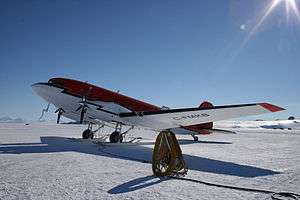Basler BT-67
The Basler BT-67 is a utility aircraft produced by Basler Turbo Conversions of Oshkosh, Wisconsin. It is a remanufactured and modified Douglas DC-3; the modifications are designed to significantly extend the DC-3's serviceable lifetime. The conversion includes fitting the airframe with new Pratt & Whitney Canada PT6A-67R turboprop engines, lengthening the fuselage, strengthening the airframe, upgrading the avionics, and making modifications to the wing leading edges and wingtips.
| BT-67 | |
|---|---|
 | |
| A Kenn Borek Air Basler BT-67 at Williams Field, Antarctica (2008) | |
| Role | Cargo aircraft |
| Manufacturer | Basler Turbo Conversions |
| Introduction | January 1990 |
| Number built | 66 |
| Unit cost | |
| Developed from | Douglas DC-3 |
Due to the slightly higher fuel consumption of the turbine engines of the BT-67, compared to the original piston designs fitted to the standard DC-3, range on the standard fuel tank, with 45 minute reserve, is reduced from 1,160 to 950 nautical miles (2,150 to 1,760 km). Basler provides a long-range fuel tank which increases the aircraft range to 2,140 nmi (3,960 km).[2]
Gunship version
The Basler BT-67 has a gunship version used by the Air Forces of Colombia.[3] The Colombian gunships are equipped with a forward-looking infrared (FLIR) ball, enabling the aircraft to conduct effective nighttime missions.[4]
Basler Turbo Conversions offered its BT-67 gunship with FLIR ball sensors and night-vision goggle (NVG) compatible cockpit to the Philippines on 12 October 2016.[5]
Operators
Civilian operators
_at_Missoula%2C_Montana.jpg)

- Alfred Wegener Institute for Polar and Marine Research, Germany
- Australian Antarctic Division (operated by Kenn Borek Air)[6]
- North Star Air, Canada
- Kenn Borek Air, Canada
- Polar Research Institute of China, China (operated by Kenn Borek Air)[7][8]
- United States Forest Service, United States
Military operators
- Colombian Air Force;[9] Colombian Air Force designation AC-47T
- National Police of Colombia [10]
- Mali Air Force[13]
- Mauritanian Air Force[14]
Accidents and incidents
Specifications (BT-67)
Data from Born Again Basler[17] and Jane's Civil and Military Aircraft Upgrades 1994–95[18]
General characteristics
- Crew: Two (pilot & co-pilot)
- Capacity: 38 Passengers
- Length: 67 ft 9 in (20.65 m)
- Wingspan: 95 ft 0 in (28.95 m)
- Height: 16 ft 11 in (5.15 m)
- Empty weight: 15,700 lb (7,121 kg)
- Max takeoff weight: 28,750 lb (13,041 kg)
- Powerplant: 2 × Pratt & Whitney Canada PT6A-67R turboprop engines, 1,281 shp (955 kW) each
- Propellers: 5-bladed Hartzell constant speed propellers, 9 ft 7 in (2.92 m) diameter
Performance
- Maximum speed: 285 kn (328 mph, 528 km/h)
- Cruise speed: 210 kn (240 mph, 390 km/h)
- Range: 2,140 nmi (2,460 mi, 3,960 km) with 45 minute reserve and long-range fuel tank
- Service ceiling: 25,000 ft (7,600 m)
See also
Related development
- Douglas DC-3
- Conroy Turbo-Three, a similar turboprop DC-3 conversion.
- Conroy Tri-Turbo-Three, a tri-motor turboprop DC-3 conversion.
Related lists
References
- "Eight FAQs". web site. Basler Turbo Conversions, LLC. Archived from the original on March 23, 2012. Retrieved March 12, 2012.
- "Archived copy". Archived from the original on 2015-07-01. Retrieved 2015-07-01.CS1 maint: archived copy as title (link)
- "Aeronave AC47 Fantasma culmina fase de inspección mayor en CAMAN". Colombian Air Force. Archived from the original on 11 August 2017. Retrieved 10 August 2017.
- "Colombia's AC-47T Fantasmas Are Still Going Strong". War Is Boring. 3 October 2016. Archived from the original on 16 August 2017. Retrieved 16 August 2017.
- "Archived copy". Archived from the original on 2017-07-29. Retrieved 2017-07-23.CS1 maint: archived copy as title (link)
- "Basler BT-67 aircraft". Australian Antarctic Division. Archived from the original on 2019-07-02. Retrieved 2019-07-02.
- "China to facilitate aviation support in Antarctic research expeditions". Archived from the original on 12 January 2014. Retrieved 9 January 2014.
- "China to deploy aircraft in Antarctica expedition". Xinhua. September 25, 2015. Archived from the original on 15 October 2015. Retrieved 15 February 2019.
- Hoyle 2015, p. 35.
- Rivas 2015, p. 120.
- Hoyle 2015, p. 37.
- Hoyle 2015, pp. 38–39.
- "Archived copy". Archived from the original on 2017-09-07. Retrieved 2017-09-07.CS1 maint: archived copy as title (link)
- Hoyle 2015, p.43.
- Hoyle 2015, p. 50.
- "6th Special Operations Squadron". Archived from the original on 2017-09-02. Retrieved 2017-09-08.
- Flight International 24–30 April 1991, p. 42.
- Michell 1994, pp. 245–246.
- "Born Again Basler". Flight International. Vol. 139 no. 4264. 24–30 April 1991. pp. 40–43.
- Hoyle, Craig (8–14 December 2015). "World Air Forces Directory". Flight International. Vol. 188 no. 5517. pp. 26–53. ISSN 0015-3710.
- Michell, Simon (1994). Jane's Civil and Military Upgrades 1994–95. Coulsdon, Surrey, UK: Jane's Information Group. ISBN 0-7106-1208-7.
- Rivas, Santiago (October 2015). "Fighting Colombia's Drug War". Air International. Vol. 89 no. 4. pp. 118–121. ISSN 0306-5634.
External links
| Wikimedia Commons has media related to Basler BT-67. |